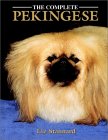
The Complete Pekingese
The Pekingese is an independent breed, which can be wilful, but owners who train their Peke puppies well can develop strong bonds with their Pekes. It's important to allow them to meet other dogs and people, because they can be suspicious of strangers, especially if they don't get out much.
They are generally quiet indoors, so long as they are taken on a little stroll now and then, or have indoor games to play. Like many small dogs, they can take a while to housetrain, and a short walk helps to stimulate their bowels and bladders. The Pekinese needs a fair amount of grooming, and they can shed a lot.
The main problem with Pekinese dogs is their vulnerability to health problems, so do check the longevity of the ancestors of any pup you are considering, and ask what problems they may have suffered from. Common problems include heart, eye, knee, and respiratory trouble, and difficulties giving birth. They can also suffer from heatstroke, so should not be allowed out for long periods at mid-day in the summer, or left in parks cars in full sun. Their backs are vulnerable to injury, so they should be picked up with care, and not allowed to leap off the furniture. They may also fart a lot, though this is generally less noticeable if they are taken for enough short walks, and are fed carefully. Tripe-based foods are not recommended, because they tend to make dogs smellier, and soya-based foods tend to lead consumers to produce more wind, so should also be avoided.
This book is a useful guide to the breed, with an account of its history in the court of Imperial China, and its introduction to Europe. There's a lot of help with choosing a pup, and on caring for your Pekinese, including avoiding and dealing with health problems. There is also advice on breeding and showing Pekinese dogs.



